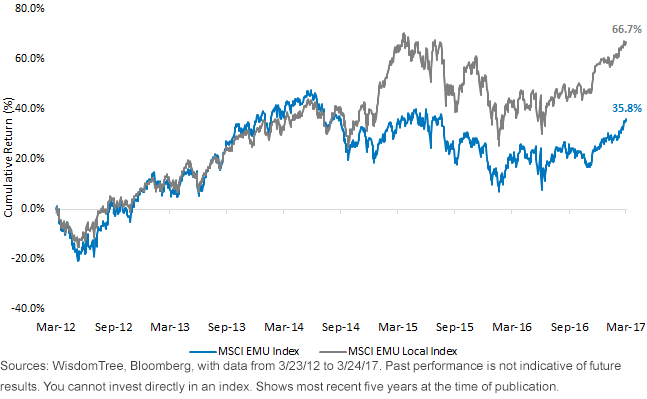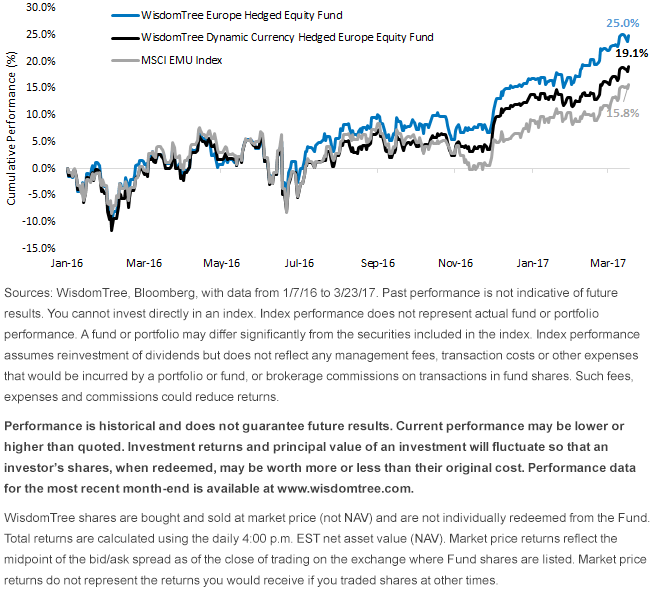What Does the Undervaluation of the Euro Mean for Your Currency Hedge?


In my last blog post on international investing, I suggested that currency hedging has a branding problem. I hypothesized that due to legacy naming issues, currency-hedged strategies seem like more exotic choices, whereas the unhedged options really are investments that contain two sources of risk: the equity markets risk and the currency risk. Currency-hedged strategies, despite having more exotic sounding names, really target just one source of risk and return: the local equity markets.
In European markets over the last five years, taking on the euro unhedged has been a losing bet: The euro has drifted downward from levels as high as 1.393 to the U.S. dollar in 2014 to low as 1.038 in late 2016. The euro has rallied a little from its bottom toward levels near 1.06 as of this publication.
For eurozone stocks over the last five years, the difference in returns was a drag from currency of more than 4 percentage points per year; on a cumulative basis, the drag from the currency bet losing turned a greater than 60% cumulative return into just a 30% plus cumulative return.
Cumulative Performance 3/23/12–3/24/17

For European Equities Today: Is Now the Time to Be Bullish on the Euro?
But of course those are past returns. What about the future for the euro? Certainly, some people are saying the euro looks like a “value” proposition and is undervalued versus the U.S. dollar. In a further research piece, we will explore valuations of the euro for various European countries. While the euro may be too weak for countries like Germany, perhaps for countries like Portugal, Greece, Spain and Italy the euro is not weak enough. Moreover, valuations of currencies are not the best short-term timing indicator—any adjustments that come from currency deviations from a currency “fair value” can take a long time to mean revert.
For instance, for many of the years between 2003 and 2010 and all the way through 2014 the euro traded well above its fair value levels, and it took more than a decade from when it crossed above an OECD measure of fair value in 2003 before it started trading consistently below a fair value.1 By that measure, it could be 2025 or later before the euro crosses back through a fair value territory.
On the other hand, we believe interest rate differentials are much more meaningful as short-term timing indicators. And by this score, while it is true that some are increasing odds that the European Central Bank (ECB) might act to taper its negative interest rate policy in 2017, the U.S. Federal Reserve (Fed) has hiked its short-term interest rates twice in the last three months and may be on a path to hike interest rates as many as four times in 2017. The differences in these short-term rates can be a powerful signal in terms of when it makes sense to hedge currencies, and therefore we have two signals pointing to opposite directions: Valuations suggest the euro is undervalued, while interest rates suggest a stronger dollar and weaker euro.
Using a Factor Model to Determine Currency Exposure
WisdomTree developed a dynamic hedged index and exchange-traded fund (ETF) family to try to help investors time their currency exposure when the factors suggest a stronger or weaker euro. The dynamic signals incorporate a three-factor approach to currency risk management: interest rate differentials (which suggest being hedged), valuations (which suggest not being hedged) and momentum (which suggests being hedged).
Our Dynamic Currency Hedged Europe Equity Fund (DDEZ) today has a two-thirds hedge ratio on, while investing in a broad basket of dividend-paying stocks. This ETF has 14.5 months of history and has seen its hedge ratio as low as 50% and high as 83.3% since its inception. If the momentum signal were to roll over, its hedge ratio would drop from two-thirds hedged to one-third hedged, as the interest rate differential signal would suggest staying hedged for some time—as long as the ECB has a lower short-term rate than the Fed.
Over the last 14.5 months, this dynamically hedged eurozone ETF has outperformed the unhedged MSCI EMU Index by more than 300 basis points (bps), while it lagged WisdomTree’s flagship 100% currency-hedged European ETF of eurozone exporters, the WisdomTree Europe Hedged Equity Fund, HEDJ.2
Cumulative Performance 1/07/16–3/23/17

Click for standardized performance of the WisdomTree Europe Hedged Equity Fund and the WisdomTree Dynamic Currency Hedged Europe Equity Fund.
Exporter Tilt Paying Off for HEDJ
The exporter tilt has also paid off from a stock selection basis, so there is some outperformance of HEDJ over DDEZ from that perspective as well. On a local to local currency basis, the stocks in HEDJ outperformed the MSCI EMU Index by about 900 bps, and a predominance of that performance came from under-weighting eurozone Financials, which lagged; identifying strong performance Financials in Spain; and then over-weighting and tilting to outperforming Consumer Discretionary and Industrials stocks.
The Future of the Euro?
As investors contemplate the moves in the euro and think about what those moves mean for returns looking forward, we’d remind them that currency has added to volatility of European stocks, while not adding to expected returns. I call this a form of taking uncompensated risk. Why take this euro risk or bet unless you have a bullish tactical view of the euro?
While valuations might suggest that it is a better time to take on the euro than it was five years ago, our dynamic currency factor model, which we think can create a series of positive expected returns, suggests being two-thirds hedged.
Change Your Default Allocation
The only proposition for European equities I personally would not advocate for is being unhedged all the time. I can argue for fully hedging the euro for the volatility-reduction benefits or dynamic hedging to take euro bets when the odds are most in your favor. DDEZ could be a great option for those who don’t want to have to rotate between hedged and unhedged on their own.
1Source: OECD, with 2003–2010 referring to data from 5/30/03 to 6/30/10 and 2014 as 10/31/14.
2Sources: WisdomTree, Bloomberg, with data from 1/7/16 to 3/23/17.
Important Risks Related to this Article
There are risks associated with investing, including possible loss of principal. Foreign investing involves special risks, such as risk of loss from currency fluctuation or political or economic uncertainty. Investments in currency involve additional special risks, such as credit risk and interest rate fluctuations.
DDEZ invests in derivatives in seeking to obtain a dynamic currency-hedge exposure. Derivative investments can be volatile, and these investments may be less liquid than other securities, and more sensitive to the effects of varied economic conditions. Derivatives used by the Fund may not perform as intended. A Fund that has exposure to one or more sectors may be more vulnerable to any single economic or regulatory development. This may result in greater share price volatility. The composition of the Index underlying the Fund is heavily dependent on quantitative models and data from one or more third parties, and the Index may not perform as intended. The Fund invests in the securities included in, or representative of, its Index regardless of their investment merit, and the Fund does not attempt to outperform its Index or take defensive positions in declining markets.

Jeremy Schwartz has served as our Global Chief Investment Officer since November 2021 and leads WisdomTree’s investment strategy team in the construction of WisdomTree’s equity Indexes, quantitative active strategies and multi-asset Model Portfolios. Jeremy joined WisdomTree in May 2005 as a Senior Analyst, adding Deputy Director of Research to his responsibilities in February 2007. He served as Director of Research from October 2008 to October 2018 and as Global Head of Research from November 2018 to November 2021. Before joining WisdomTree, he was a head research assistant for Professor Jeremy Siegel and, in 2022, became his co-author on the sixth edition of the book Stocks for the Long Run. Jeremy is also co-author of the Financial Analysts Journal paper “What Happened to the Original Stocks in the S&P 500?” He received his B.S. in economics from The Wharton School of the University of Pennsylvania and hosts the Wharton Business Radio program Behind the Markets on SiriusXM 132. Jeremy is a member of the CFA Society of Philadelphia.

